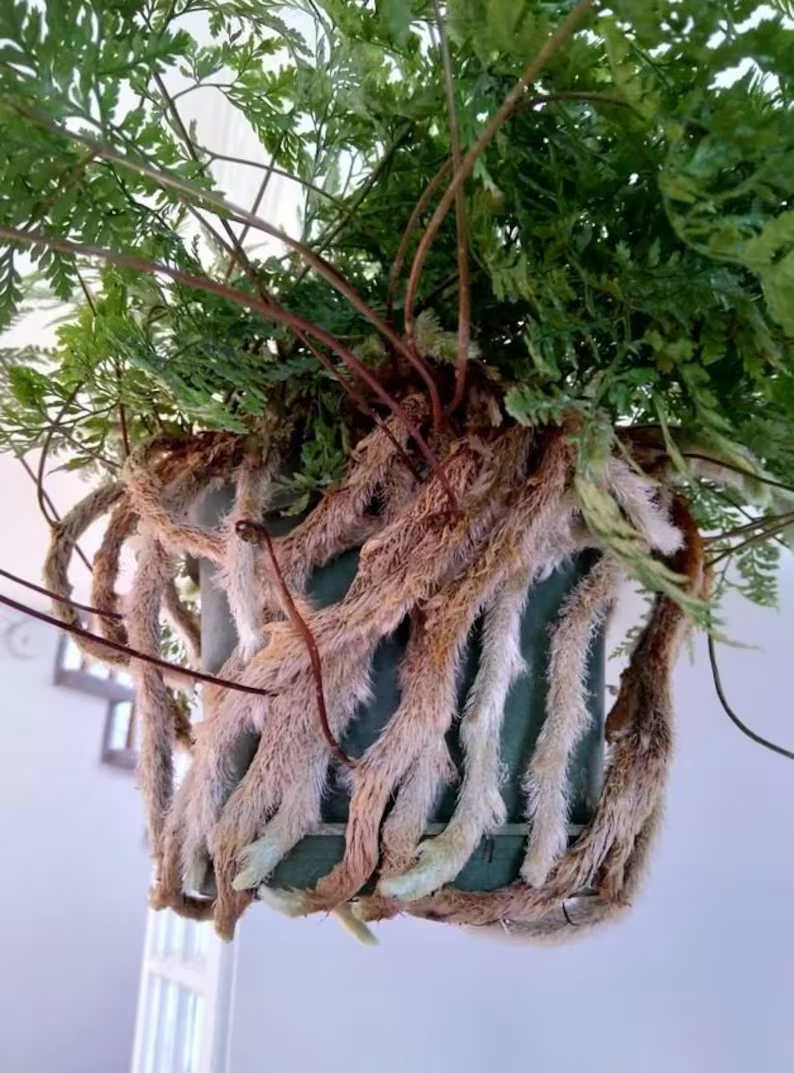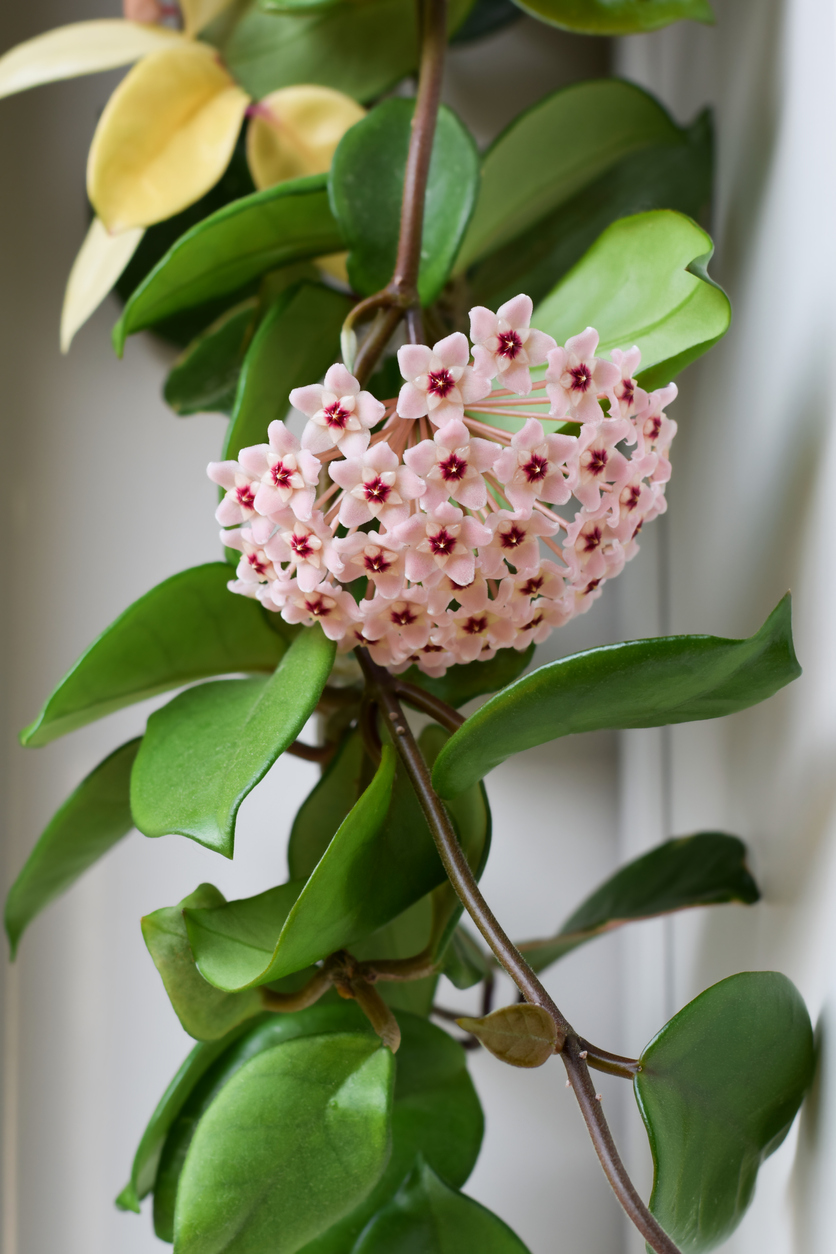

We may earn revenue from the products available on this page and participate in affiliate programs. Learn More ›
The best indoor hanging plants produce floods of attractive foliage while tolerating typical household conditions. Unless otherwise indicated, the following types prefer bright indirect light, average indoor temperatures, and moderate amounts of water.
To show off your green thumb, look for creative ways to hang plants indoors, such as from brackets rather than ceiling hooks or with macramé hangers rather than plastic ones. By doing so, you often can decorate with plants while keeping dangerous foliage out of the reach of pets or toddlers. If you don’t have babies intent on pulling plants down, you also can place cascading species atop pedestals rather than stringing them up.
Related: 8 Exotic Houseplants You’ve Never Heard Of
1. Arrowhead Vine (Syngonium podophyllum)

The most vining type of Syngonium, this one hits the bull’s-eye for ease of care and attractive foliage, with its arrowhead-shaped green leaves marked with white. Keep in mind that the leaves may develop lobes as they age and contain calcium oxalate crystals, which can cause mouth irritation if they are ingested by a toddler or pet.
2. Christmas Cactus (Schlumbergera spp.)

Christmas cacti, with their clawed or scalloped segmented foliage, often grow into large, hanging indoor plants over a number of years. So even without their dangly tiered blooms that come in a variety of colors, they make an impressive show. The flowers are most likely to appear if you move the plants to a shaded position outdoors over the summer to expose them to shortening days and cooler temperatures before you return them to the house.
3. Devil’s Ivy (Epipremnum aureum)

Despite its name, this “ivy”—also known as golden pothos—is an angel indoors, displaying fast-growing vines loaded with leathery, yellow-variegated, heart-shaped leaves. In fact, it has earned a reputation as one of the easiest hanging vine plants to grow. So reward its ease of care with your best hanging planter. The “devil“ in its moniker might refer to the fact that it will cause your mouth to burn if you are foolhardy enough to eat it.
4. English Ivy (Hedera helix)

The same ivies associated with colleges can make your home look smart since they are easy plants to grow and will cascade down from an indoor plant hanger as easily as they climb campus walls. Their three- to five-lobed leaves can be solidly green or variegated with white or yellow. You might want to hang them in the bathroom during winter (or mist them regularly) since they tend to attract spider mites if exposed to extremely dry air.
Related: 14 of the Fastest-Growing Houseplants for a Nearly Instant Indoor Garden
5. Goldfish Plant (Columnea spp.)

The goldfish plant can provide an indoor space with orange fish shapes swimming amid lush greenery without the necessity of an aquarium. Actually, the color of those fish flowers, which only appear in spring and summer, varies from yellow to orange to red, according to cultivar, and the foliage from glossy to hairy. Give it consistent water, but avoid irrigating it with hard water or getting water on the leaves, which can cause spotting or rotting.
6. Grape Ivy (Cissus alata, aka rhombifolia)

Although the foliage of this plant doesn’t really resemble grape leaves, it does have grape-like tendrils. It also can grow with grape-like speed in less-than-bright locations, and therefore it is one of the most vigorous low-light indoor hanging plants. Both branches and new leaves tend to be fuzzy, while older foliage is glossy. Allow the soil to dry out between waterings.
7. Heartleaf Philodendron (Philodendron scandens)

Probably best known for its use in funeral dish gardens, this small vine can grow to more prodigious proportions in hanging baskets. Plus, it tugs at many heartstrings with its heart-shaped leaves. Keep in mind that those leaves tend to grow larger when the vining plant is allowed to climb by its aerial roots rather than by dangling.
8. Kangaroo Vine (Cissus antarctica)

Closely related to grape ivy with, with which it is often confused, the kangaroo vine has what Tovah Martin in The Unexpected Houseplant calls “beech-shaped” leaves. The plant authority finds its foliage boring when compared with the three-leaf leaflets of its more complicated kin, but she admits that “you can’t kill it. If survival is your primary criterion, go for it.” Or rather, jump to it!
Related: Beyond Poinsettias: 23 Houseplants That Bloom in Winter
9. Piggyback Plant (Tolmiea menziesii)

Native to the Pacific Northwest, this plant carries new plantlets piggyback—or perhaps more correctly piggy-front—in the axils of its hairy and heart-shaped leaves. When you’re hanging plants indoors, place this one in a humid location, keeping its soil lightly moist at all times. It’s also called curiosity plant, but take care; its foliage can cause itching and blisters, so don’t handle it bare-handed.
10. Rabbit’s Foot Fern (Davallia solida var. fejeensis)

Children will love the furry rhizomes like rabbits’ feet that peek out from under the leathery but finely cut foliage of this plant. You will love the fact that, according to North Carolina State Extension, “This fern is more tolerant of low humidity situations than other ferns.” However, it’s still best to keep it in a humid location such as a bathroom or over the kitchen sink, make sure that its soil stays damp, and never cover its “feet,” since these rhizomes that spill out of the hanging basket can become fronds.
11. Spider Plant (Chlorophytum comosum)

Spider plant, with its strappy, arching, and often white-striped foliage, is often grown in a hanging basket to allow plenty of room for its small white flowers and plantlets to dangle down on all sides. Avoid giving it fluoride-treated water, which can cause brown spots on the tips of its leaves, though those can also be due to an excess of fertilizer. Other than those cautions, this is an easy plant to grow, even for beginners.
12. Strawberry Begonia (Saxifraga stolonifera)

Speaking of plantlets, the so-called strawberry begonia also throws out plenty of those, occasionally accompanied by panicles of white flowers in late spring. Not actually a begonia, it still resembles one with its rosettes of roundish leaves painted red underneath. The upper sides of the leaves can have silver veins in the species variety or be edged with white variegation in the Tricolor cultivar.
13. String of Hearts (Ceropegia woodii)

Also sporting silver-marked green foliage with a ruddier underside, the string of hearts vine somewhat resembles beaded curtains with heart-shaped leaves and candle-shaped violet flowers replacing the beads on its skinny strings. Since it is a succulent member of the milkweed family, it prefers a little more sun and a little less water than most of the other plants listed here.
Related: 21 Vertical Garden Ideas for Those Short on Space
14. String of Pearls (Senecio rowleyanus)

With its spherical green leaves resembling a cascade of pearls—or peas—this plant has a well-rounded look that is all its own. Also a succulent, it will tell you if it isn’t getting enough water because its beads will turn from plump to pancaked. If provided with cool conditions during winter, string of pearls may produce small white, cinnamon-scented blooms in spring or summer.
15. String of Turtles (Peperomia prostrata)

If you aren’t into pearls, try a string of turtles instead. As easy to grow as most peperomias are, this one produces roundish leaves decorated in intricate purple and green patterns that resemble turtle shells. It also remains small enough not to topple an indoor hanging plant stand. Don’t take its common name too seriously, and be sure to keep its soil moist but not soppy, since these turtles can’t swim.
16. Swedish Ivy (Plectranthus verticillatus)

First popularized by a botanist whose club offered unusual houseplants to Swedish housewives, this species won favor due to its easygoing nature. With shiny, scalloped leaves and occasional spikes of pale pink blooms (usually as late spring gives way to early summer), the plant thrives under average indoor conditions. It is still sometimes sold under its old name, Plectranthus australis.
17. Velvet Plant (Gynura aurantiaca)

Its hairy new leaves are an intense violet color almost as psychedelic as a hue from a 1970s velvet painting. However, the velvet plant probably isn’t to everyone’s taste. For one, the small yellow blooms that appear infrequently on this aster relative can smell like the literal unwashed. But it should appeal to those who enjoy the unusual, and its sprawly habit is appropriate for a hanging basket. Keep in mind, however, that it tends to turn more green and less purple as it ages.
18. Inch Plant (Zebrina zebrina)

Like the strawberry begonia and string of hearts plants, this vining plant’s leaves also have silver and green up top and redder shades underneath. However, its leaves are oval and pointed at the tips. Because it can root wherever it touches the soil, this vining plant fills up a basket very quickly and scrambles over the edge looking for more room, making it one of the most vigorous hanging vine plants.
19. Wax Plant (Hoya carnosa)

True to its name, the wax plant produces both waxy foliage along with waxy flowers that are usually tiny pink and white blooms, showier than those of most indoor hanging plants. However, the plant can be difficult to bring into flower, and it usually only blooms after a few years. Insufficient light is usually the cause, but avoid hanging it in direct sunlight. It also helps to avoid pruning stems that have flowered; the blooms form on the same stem each year. Hoya’s somewhat succulent-looking foliage can do just fine on its own. In addition, the small-leafed Hoya bella reportedly is one of the best types for baskets.
